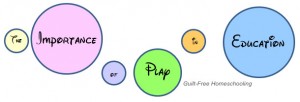I recently received an email from a new-to-homeschooling mom, asking several questions and expressing her anxiety over the first year of educating her children at home. Due to a glitch in the email system, her letter arrived with an incomplete email address, preventing me from answering her personally. Since her questions and comments (listed below in bold type) are of such general interest, allow me to answer them here in a more public forum and thereby share my advice, encouragement, and links to related articles with others who may need them also.
Dear Jane Doe,
What you referred to as the anxiety-producing elements of homeschooling are exactly the same as what I refer to as the guilt-producing aspects. My initial reaction to any homeschooling dilemma I encountered was certainly anxiety, followed quickly by guilt if and when I neglected to address the problem. I am convinced that each and every homeschooling parent deals with these feelings from time to time (which is why this website exists!). Please do not feel that you are alone; we have all been there.
You asked how to avoid the thoughts that intrude on your daily routine. I wish I knew. However, while I do not know how to prevent the thoughts from entering one’s head, I can recommend some ways I dealt with the thoughts once they occurred:
— I ignored them.
— I reminded myself of why we chose to do what we were doing.
— I made a list of our reasons for homeschooling and referred to it often.
— I talked to other homeschooling parents, and we encouraged each other.
What if I miss something?
Many new homeschooling families wonder if they are covering enough material, if they are doing enough activities, or if they are missing some important areas altogether. My advice is to take on this project of homeschooling in the same way you would take on any other project: make a plan, and then follow it. Begin by planning how to cover the academic basics: language & grammar, mathematics, science, history. Include the areas that are important to your family’s values: Bible, manners, sex education (from your family’s point of view). Add a few independent living skills as the opportunities arise: cooking, laundry, money management, home repair, auto maintenance. Balance it all out with your students’ areas of personal interests: music, sports, art, drama, animal care. Once you have taught your student how to teach himself through reading and research, you can turn him loose to learn any other supplemental things his little heart desires.
Obviously, a Kindergarten student does not need the same aggressive academic program that a high school student needs. Beginners and early elementary students need to master reading, handwriting, counting, adding, and subtracting before they can fully understand the concepts of history, geography, and science (subjects which can wait to be introduced until 4th grade). [See Where Do I Begin? and Too Much, Too Fast = Burnout]
What if the public school students are ahead in something?
Focus on what your student is doing and what your student needs help in. Your student may be ahead in some areas and behind in others, but it also may not matter very much in the grand scheme of things. (By the time they began high school, my students were ahead of their peers in mathematics and public speaking skills, but far behind their public-schooled peers in foul language and sexual promiscuity.) Back when we were all first-time parents, we were told not to worry about whose child rolled over first, whose child crawled first, or whose child got the first tooth. We were told that by the time they all were fifteen years old, no one would be able to tell which child did what first. The same applies to homeschooling: once our children reach their forties, no one will know (or care) at what age they first learned to use punctuation.
When my child misbehaves, is it because we are homeschooling?
It might be; but it might not be. If your child is objecting to pursuing education at home, behavior issues may occur. It may also be attributed to lesson plans that are not suited to your child’s style of learning. For example, if you are presenting a lesson on volume by merely asking your child to read the explanation in the math book, but your child would learn better by stacking and counting sugar cubes, the child just may not be “getting it” and is acting out his frustration. Another time the child may be bored because the material is too simple and would benefit from moving on to more advanced lessons. [See Learning Styles and Kids Will Be Kids]
What if they grow up to resent my homeschooling them?
Resentment can come from many sources. Immature people (regardless of age) resent anyone’s attempts to influence them. An immature child may temporarily resent being pulled away from what he or she considers to be social contacts of major importance. With maturity will come the realization that Mom and Dad knew best and did what they felt they had to do.
Some may point out that not every family claiming to “homeschool” is doing an adequate job. In the worst cases, I have to say that students can be truant from homeschooling as well as truant from public schooling, but both cases are more likely to be the result of parental neglect than educational neglect. In such situations, the lack of parental involvement will be resented more than the lack of schooling. [See “Parent” Is a Verb]
I know I should relax… I don’t want constant worry to ruin the experience.
Are you doing the best job that you can do at this time? Are you trying to learn what you can do to improve upon your weaknesses? That is all anyone can ask of you. Take one step at a time, handle one task at a time, and tackle one day at a time. You and your children are in this experience together — work together as a team and discover new things together. No one is ever too old to learn something new: education is a life-long process. As you focus on the experiences themselves, you will begin to realize how much your children (and you) are learning, instead of worrying about what your students are possibly missing. [See Do the Best Job You Can…]
I feel that God has called me to do this and that He wouldn’t ask me to do it and then not help me.
Very true. What God asks us to do, He also equips us to do. Now trust Him that He still knows what He is doing.
Every homeschooler I have ever spoken with has gone through the same thoughts of guilt or anxiety at some point in time. Some of us are able to overcome our feelings of inadequacy quickly, and others of us take a little longer and need more encouragement. Reach out to other homeschoolers you know and share your experiences with them. Chances are good that you will find that they have gone through the exact same emotions. However, a positive byproduct of sharing is that you will learn from each other, and you both may come away with some new techniques to try or some new ideas for activities and lessons. You may even decide to get your students together for group activities or field trips.
When I reached my second September as a homeschooling parent, I began to feel better about what I was doing. I had gone through this process at least once before, and I began to feel like a “veteran.” The longer I homeschooled my children, the more experience I had to fall back on, and the more I knew about my students and the ways in which they learned. I have said before that the first year of homeschooling is often the most difficult because it is entirely uncharted territory, both for the teacher and for the students. Do not give up too quickly. Be encouraged — your worst days may already be behind you.
[For further information on this topic, see Surviving the First Year of Homeschooling after Leaving Public School.]





 Guilt-Free Homeschooling is the creation of Carolyn Morrison and her daughter, Jennifer Leonhard. After serious disappointments with public school, Carolyn spent the next 11 years homeschooling her two children, from elementary to high school graduation and college admission. Refusing to force new homeschooling families to re-invent the wheel, Carolyn and Jennifer now share their encouragement, support, tips, and tricks, filling their blog with "all the answers we were looking for as a new-to-homeschooling family" and making this website a valuable resource for parents, not just a daily journal. Guilt-Free Homeschooling -- Equipping Parents for Homeschooling Success!
Guilt-Free Homeschooling is the creation of Carolyn Morrison and her daughter, Jennifer Leonhard. After serious disappointments with public school, Carolyn spent the next 11 years homeschooling her two children, from elementary to high school graduation and college admission. Refusing to force new homeschooling families to re-invent the wheel, Carolyn and Jennifer now share their encouragement, support, tips, and tricks, filling their blog with "all the answers we were looking for as a new-to-homeschooling family" and making this website a valuable resource for parents, not just a daily journal. Guilt-Free Homeschooling -- Equipping Parents for Homeschooling Success!

Recent Comments